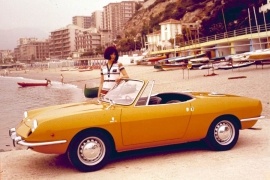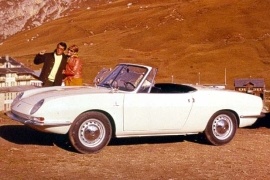FIAT 850 Spider Models/Series Timeline, Specifications & Photos
First production year: 1965
Engines: Gasoline
Body style: Convertible (spider/spyder, cabrio/cabriolet, drop/open/soft top)
The Fiat 850 was already successful on the market as a 3-door hatchback and as a coupe. The addition of the open-top version was nothing but enhanced pleasure for its driver.
Fiat was already known for its small-sized vehicles, with its very good fuel-efficiency engines. Models such as 500 and 600 were already crossing the European continent and managed to find parking spots where no other cars could fit. The 850 was a larger vehicle, so four adults could fit in. But there also was an increasing demand for open-top vehicles. By using the same platform, Fiat managed to introduce the 850 Spider in 1965, simultaneously as the 850 Coupe, at the Geneva Motor Show.
Fiat hired Bertone studios to design the open-top version of the 850, and he started from the coupe version. It narrowed the front end and succeeded in building one of the most classical Italian roadsters, apart from the Alfa Romeo Spider. Its raked windshield and the completely hidden roof behind the seats left a clean image of the roadster. Due to the rear engine architecture and the small wheelbase, the car was able to fit only two passengers aboard.
Inside, Fiat asked Bertone to carry-over most of the Coupe parts to cut costs. A five-dial instrument cluster was fit into a flat dash panel split into two separate areas, so it gave the driver a race-car feeling. A floor-mounted gear-stick and an ashtray placed in the middle of the dash were the car's main visible features.
Fiat installed the 0.9-liter engine from the Coupe and paired it to a 4-speed manual gearbox under the hood. The 49 hp engine was upgraded in 1968 and gained another three ponies.
In the mid-60s, the market for affordable open-top vehicles was small and dominated mainly by British brands, and Fiat tried to change that when it introduced the 850 Spider.
The Italian automaker introduced the 850 lineup in 1964 as a replacement for the 600 model. It was a two-door vehicle that could fit four people inside and was affordable. But Fiat had bigger plans with the newly developed platform that resulted in the 850 Coupe and the 850 Spider, which was designed by the Bertone Design Studio in Turin. Unlike the closed-cabin versions, the convertible was made to enchant its owners with the open-top driving experience, and unlike the British MGs or Austin roadsters, it wasn’t made to be raced.
When Giorgetto Giugiaro penned the 850 Spider for the Bertone Design Studio, he had to adapt the car’s shapes to the platform and other components that allowed Fiat to lower production costs. As a result, at the front, he extended the fenders that incorporated the headlights and covered them with an additional piece of glass. The clean design of the hood was continued downward by a curved panel that supported the chromed bumper. Two small horizontal blinkers found their places between the bumper and the headlights.
From its profile, the low waistline of the vehicle was clean, without any fancy trims added on the doors or fenders. The only particular badge noticed was on the front fenders, where the automaker placed the Bertone logo behind the wheel arches. An almost vertical windshield was supported by thin A-pillars, with no concern for the occupants’ safety. A hard top was available at extra cost. There were no door handles, just a small button that also included the key fob and a dent on the rear fenders that allowed customers to get two fingers behind the door panel to open them. At the back, the long deck concealed the retractable canvas roof and the engine compartment. The rear fascia featured a pair of horizontal taillights and a chromed bumper underneath them.
The tiny cabin was good for two people, and the driving position was very low. Between them, Fiat installed a center console that housed the hand brake and the gear stick. The instrument cluster mounted in front of the drivers sported large dials for the speedometer, tachometer and a few smaller gauges for the fuel level and water temperature. The factory offered no center stack, but some dealers created one to mount a radio and a speaker.
Behind the cabin, in the engine bay, the tiny 850 Spider had an inline-four engine that produced less than 50 hp and was mated to a four-speed manual gearbox. The rear-wheel-driven vehicle wasn’t meant to be driven fast and couldn’t hit 90 MPH (147 kph).

